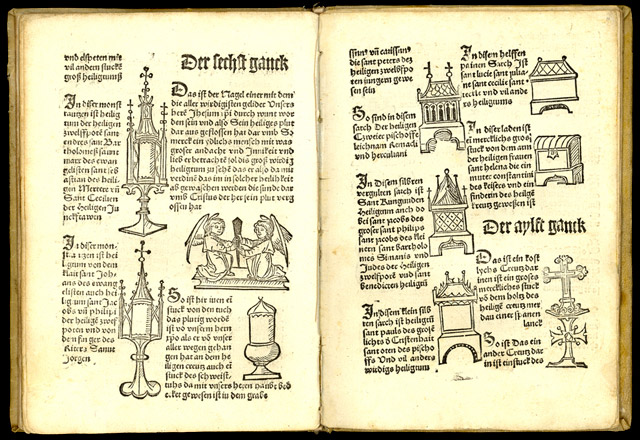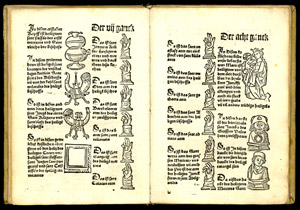Bamberg Relic-Book
Library of Congress, Washington, DC, Rare Book and Special Collections Division

 Select the image to zoom
Select the image to zoom
In 1493, the impressive collection of relics housed in the cathedral of Bamberg inspired not one but two relic-books. Additional volumes followed in 1495 and 1508/09. These books all attest to the growing popularity of the display of relics, or Heiltumsweisung. Unlike in most pilgrimage centers, where the display of relics took place each year, the Heiltumsweisung in Bamberg occurred only once every seven years. This extended cycle was a condition of the Council of Basel (1444), which decided to grant all those who saw the relics in Bamberg up to five years and two hundred days of freedom from purgatory. While this was not the first indulgence awarded to the cathedral, it demonstrates how indulgences provided the Church with a means of institutionalizing the cult of saints.
The woodcuts that accompany the relic-book printed by Hans Mair in 1493 involve a similar effort at codification. On the first folio, the viewer encounters a portrait of the Holy Roman Emperor Heinrich [Henry] II (973–1024) and his wife, Cunigunde (d. 1039), holding a model of Bamberg Cathedral. Not only were Heinrich and Cunigunde instrumental in founding the cathedral in 1021, but they also became two of the most important saints associated with it. The so-called Heinrichschrein, a reliquary casket containing remains of Heinrich II, occupies a central role in the procession pictured in the following woodcut. After these images, which became standard "types" in later relic-books, the Bamberg relic-book shows the various relics housed in the cathedral arranged into groups. These groups reflect the presentation of the relics at the Heiltumsweisung. They also reveal a certain interest on the part of the designer of the woodcuts in the reliquaries, which despite their schematized appearance retained an aspect of their individual ornamental characteristics. This suggests that relic-books were more than just "catalogs" of relics, playing an important role in the history of early printmaking.





